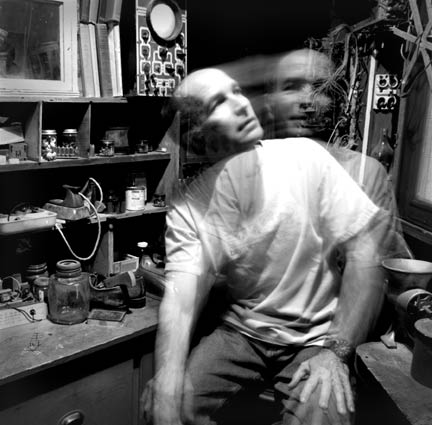
Michael McMillen is a visual artist in the very broadest sense, careful to avoid narrowly defining just what it is he does. "The medium has to be in service of the idea," he told an audience of students at Art Center College of Design in 2005.
McMillen's shifting and overlapping job descriptions -- sculptor, installation artist, printmaker, cultural anthropologist -- reflect the fact that he is a searcher, never quite sure what he is looking for, always hoping to be amazed by what he comes across. An leading edge baby boomer -- he was born in 1946 -- his childhood was marked by a curiosity about the artifacts of postwar California.
Raised mainly by his grandparents, McMillen was surrounded from an early age by things older than he was: elderly people, antique furnishings, objects that had seen better days. Being older, his grandparents also tended to let him roam. Some of McMillen's childhood memories involve pulling a wagon down the alleyway near his their house, collecting junk that he would later organize and create stories about. Since many of neighbors were veterans of WWII, or had worked for Douglas Aircraft in Santa Monica, McMillen often found items that conveyed the faded poetry of war and industry.
His imaginative drive also reflects the influence of his father, an actor who also worked as a scenic artist. Eventually McMillen Sr. worked for Channel 11, and Michael would visit him there. Walking among the sets, which he realized looked very different on television, got him thinking about the artifice and "duality" of media images. While attending Santa Monica City College he decided to become an artist: an epiphany that he says came to him like a "snap of a finger."
After earning his MFA at UCLA McMillen promptly gained attention for his mixed-media sculptures and constructed environments. "Like films," wrote one commentator, "McMillen's fastidiously constructed works function as portals into other worlds..." While building his reputation as an artist McMillen also did odd jobs in the film industry, creating props and special effects for "Blade Runner" and "Close Encounters of the Third Kind."
Since winning the LA County Museum's "New Talent Award" and landing NEA Artist's Fellowship, both in 1978, McMillen's career has never faltered. His groundbreaking 1981 installation "Central Meridian (The Garage)" featured the cluttered interior of a 60's garage/workshop/catacomb, complete with the rusting bones of a Dodge Dart. Doug Harvey, writing for the LA Weekly, says that the piece "...remains one of the most subtle, poetic and experiential critiques of the institutional art environment ever devised."
Over the years, McMillen's interests as an artist have remained remarkably consistent. Deeply aware of the evocative power of things, he has been accumulating and re-assembling "objects of interest" -- some would call them detritus -- all his life. While building his stellar reputation as an artist, an inevitable by product has been a growing storage problem.
"I have an exotic collection of materials, artifacts, gee-gaws and what-nots" says McMillen. "To avoid unnecessary clutter, I have a simple rule: If I haven't used it in 30 years, I discard it."
One of the results of being "awash with stuff" has been a deepening exploration with film. This new direction has allowed McMillen to both literally recycle some of the physical raw material he has accumulated and also to recycle some of the overarching ideas of his career. He has been tinkering with film since 2003, and his 2007 installation/exhibition "Speed's Place" at the UnMuseum of the Contemporary Arts Museum of Cincinnati, included projections of his digital films.
His current exhibition "Lighthouse" at LA Louver Gallery doesn't literally include a lighthouse. The title, McMillen explains, "... is both metaphoric and a bit literal," as the installation includes a looped screening of his new short film "Quotidian Man" which projected onto the billboard of the "Hotel New Empire," a kind of tilting film set raised on a catafalque of stilts over a tray of water.
A precarious flophouse with a questionable past it is both a sculpture and a metaphor. Adding the element of the billboard/movie screen is McMillen's way of priming the image to receive an even richer set of suggestions. The billboard may also be a nod to the late painter James Doolin's "Psychic," a 1998 oil of a blank signboard hovering above a row of LA stores.
McMillen's films are reminiscent of old films, and nostalgia -- he has great affection for the days when movie magic wasn't so seamless -- is one of their key ingredients. Paradoxically, the poetry of nostalgia recycled creates something fresh and dreamlike. "Every dream is new: we don't know where they are going," McMillen points out. Spooky mirages, grainy and full of surprises, McMillen's films somehow feel inevitable, as if he has been making them all his life.
In a sense, he has. Working with history makes him feel fresh, like a child again.
Michael C. McMillen is a man who is fascinated by the past, but who isn't the least bit jaded. His imagination flickers brightly, like a Tesla coil in a monster movie.
Michael Mc Millen Artist's Statement for "Lighthouse."
The illusions of permanence and perfection are recurring themes in my work.
I use architectural references as a metaphoric language to express and reveal this
continuous state of flux and entropy.
The viewer's memory and sense of reality are subtly subverted by the use of altered scale and the fabrication of elements that are both familiar and strangely dystopian.
With the advances in digital motion picture technology, I have been able to integrate time based images into my installations. The movies blend and combine a multitude of varied images from our popular culture into personal dream-like narratives that animate and transport the viewer into unexpected realms.
